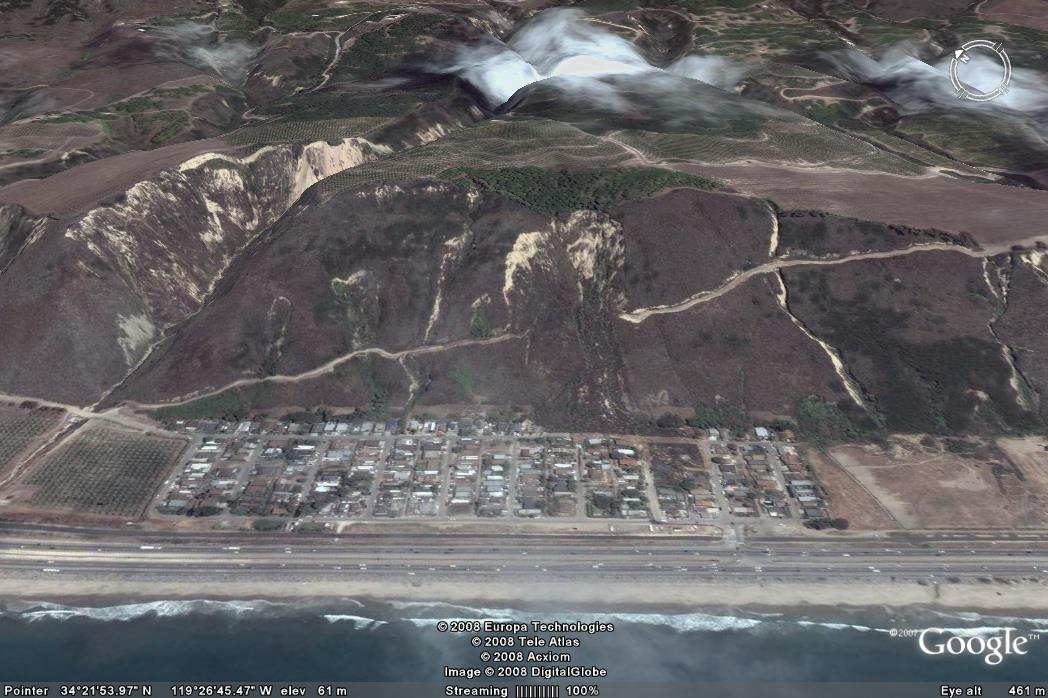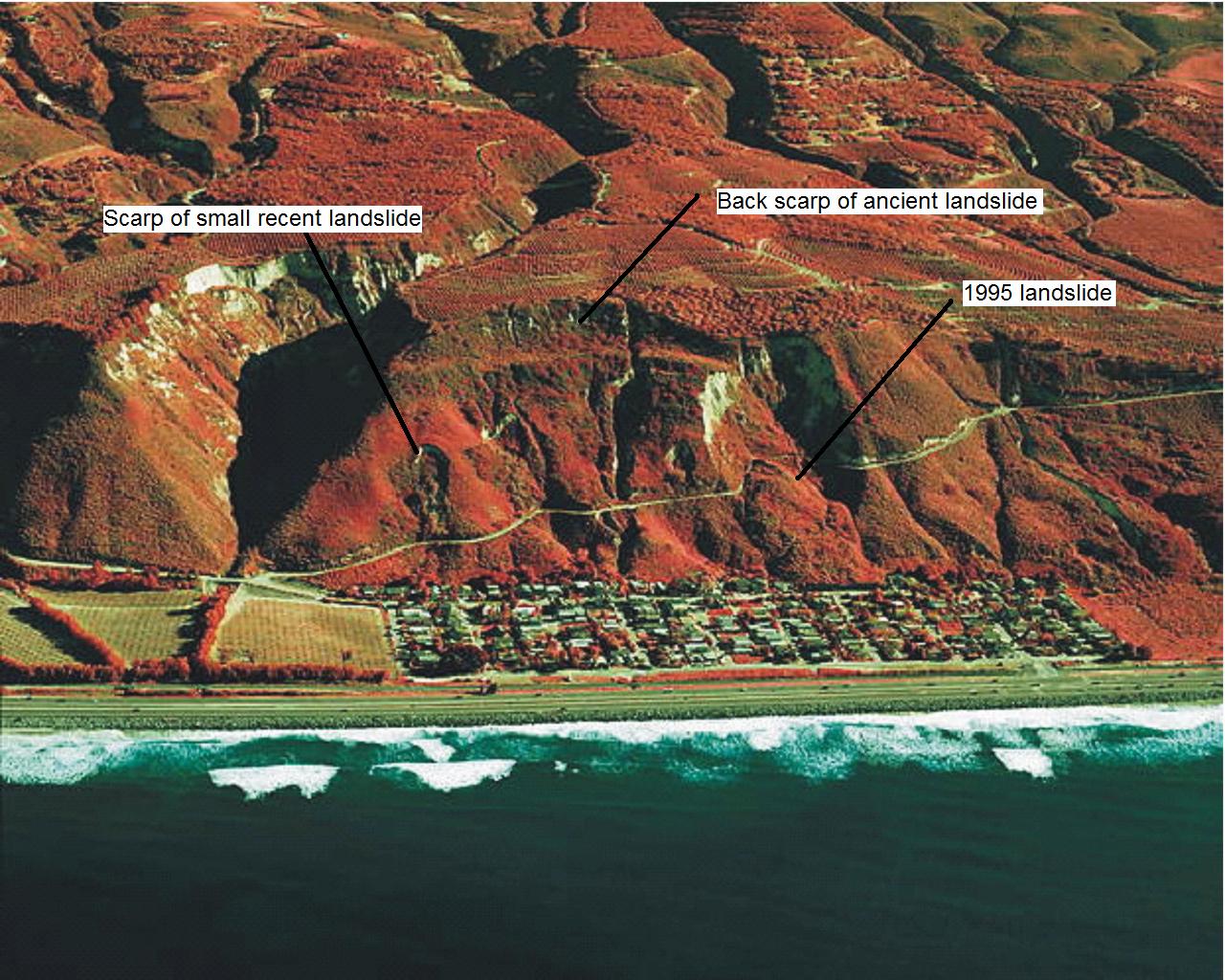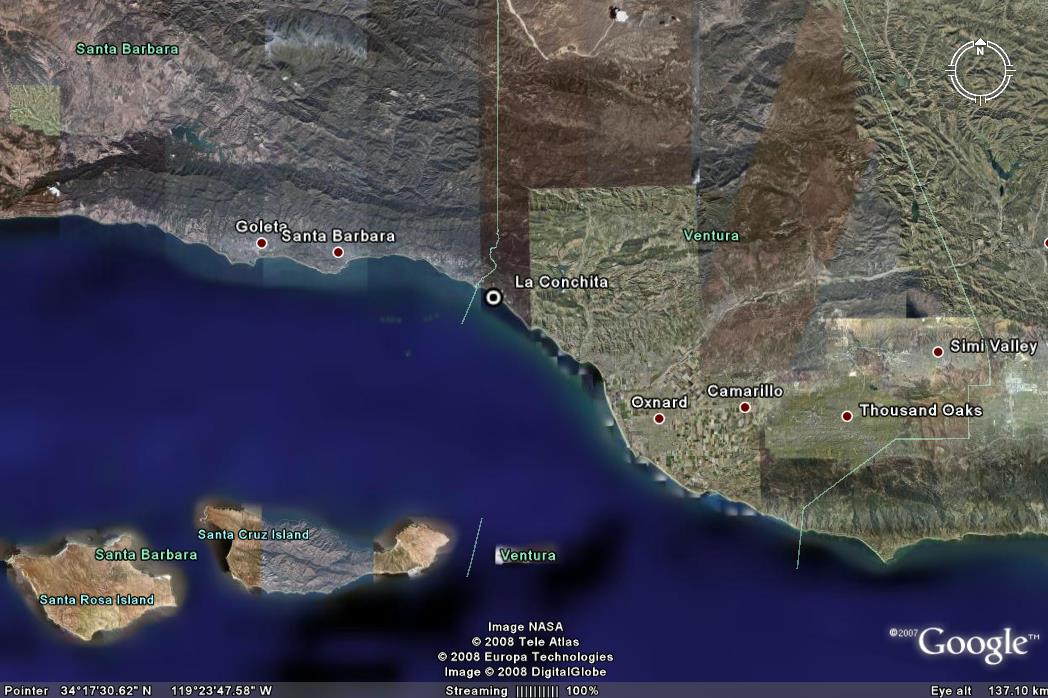20 August 2008
La Conchita landslide verdict
Posted by Dave Petley
Many readers will be familiar with the La Conchita landslide in California. For those who aren’t, La Conchita a small (population about 340 people), unincorporated seaside village located on the Pacific coast north of Los Angeles (Fig. 1) (34.4 degrees north, 119.5 degrees west). The town is located on a narrow coastal plain, with a steep slope behind. The houses are very close to the foot of the slope (Fig 2).
 Fig 2: Oblique Google Earth image showing the town of La Conchita with the steep slope behind. Note the very clear landslide scars
Fig 2: Oblique Google Earth image showing the town of La Conchita with the steep slope behind. Note the very clear landslide scarsThe town shot into the limelight on 4th March 1995 when a landslide slipped off the slope and buried or damaged seven houses. Fortunately no-one was killed, but it clearly caused considerable concern. The landslide is the subject of perhaps one of the most famous of all landslide pictures, taken by the USGS (Fig. 3). The landslide was large (120 m wide, 330 m long, and >30 m deep, with an estimated volume of 1.3 million cubic metres. However, the slide occurred as a coherent earthflow and was comparatively slow.
Unsurprisingly, in the aftermath of the landslide concerns were raised about the safety of the town. In particular, it is clear from Figure 2 that the slope is mantled with old landslide scars and deposits. There was consistency in the views of the experts that further landslides on the slope were likely. Sadly, this proved to be correct because on 10th January 2005, during a period of very heavy rainfall, a further landslide occurred. On this occasion a portion of the failed mass from 1995 remobilised and hit the upper part of the town.
Amazingly, the failure of the upper part of the landslide was caught by a TV crew (see here or below).
 Fig. 5: USGS false colour image of the La Conchita landslide complex, annotated to show the key features
Fig. 5: USGS false colour image of the La Conchita landslide complex, annotated to show the key featuresYesterday, the main part of the court case brought by the property owners against the ranch owners came to an end. I have no knowledge of the US legal system, but interestingly the verdict of the jury is that the ranch company was negligent in connection with the 2005 landslide. The land owners had claimed that the ranch company did not build an adequate drainage system. This was felt to have contributed to the event. As I understand it the drainage system was not found to be the sole cause, meaning that the negligence is shared. The court case has now moved into a second phase in which the jury will decide upon damages. Because of this it would be wrong to comment on the rights and wrongs of this case at this stage (I will do so later), but it will certainly be interesting to see what the jurors award, and to whom.





 Dave Petley is the Vice-Chancellor of the University of Hull in the United Kingdom. His blog provides commentary and analysis of landslide events occurring worldwide, including the landslides themselves, latest research, and conferences and meetings.
Dave Petley is the Vice-Chancellor of the University of Hull in the United Kingdom. His blog provides commentary and analysis of landslide events occurring worldwide, including the landslides themselves, latest research, and conferences and meetings.
This was a very interesting trial. I can tell you that the jury found shared negligence 55/45 in most cases for the following reasons: Most residents were shown to have an awareness of the hazardous condition prior to the slide. That is why they were negligent. The Ranch failed to follow the advice of their own experts in the way that they managed the slide face/material of the 1995 slide. In fact, the Ranch created a 3 foot deep drainage channel across the main portion of the slide area. They didn’t line that channel with plastic. The 2005 slide took out the channel on the right side, but a portion of the channel was still in tact on the left siderevealing that the channel had eroded to 22 feet deep in places. The Ranch’s experts had warned them that such erosion was likely to occur in an unlined channel. Such a condition would weaken the slide area, making it more vulnerable to landslides. While it was never proven that the Ranch’s failure caused the 2005 slide, the jury felt their lack of responsiveness to their own experts opened them to the charge of negligence.
Just an fyi…my take is that the jury would not have awarded the plaintiffs nearly as much as they actually received. There was not a sentiment to do that (except for one juror). I think the Ranch flinched when they took the damages out of the hands of the jurors and gave the plaintiffs the Ranch, plus the $5 M insurance. In the end, I do not believe the plaintiffs did very well on this trial. It was the lawyers and their many experts that made the money. The families of those that died, I am guessing… received much less than expected.